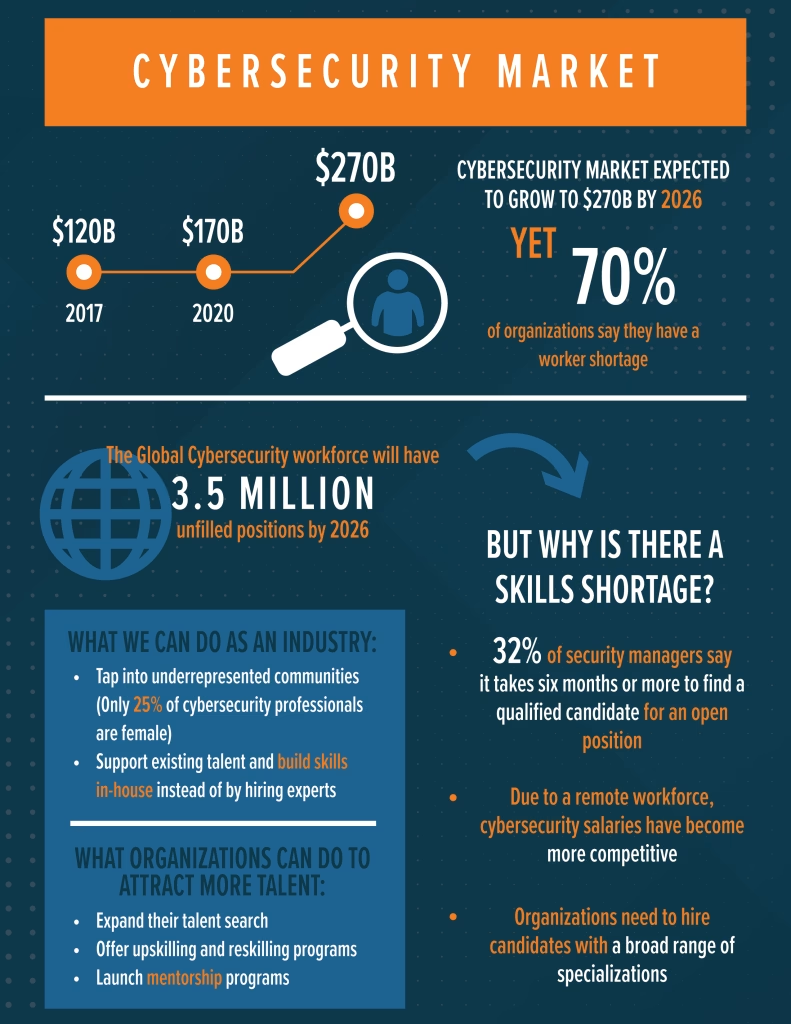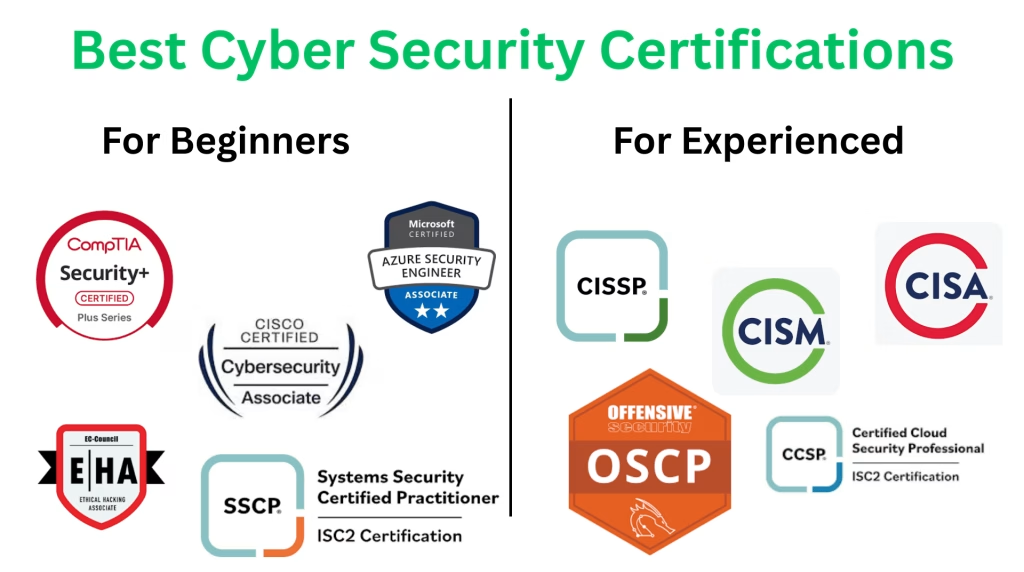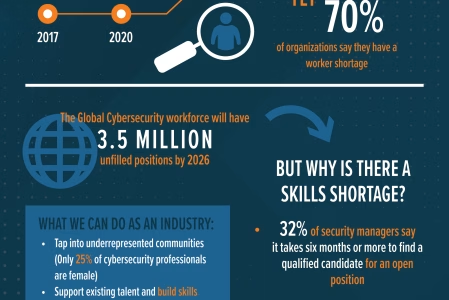
The global cybersecurity industry faces a striking paradox in 2025: while 3.5 million positions remain unfilled worldwide, entry-level candidates experience rejection rates exceeding 70%. This comprehensive analysis examines the job market for cybersecurity, shifting employer expectations since 2023, and strategic approaches that successfully launch and advance cybersecurity careers.
The cybersecurity job market rewards strategic positioning more than ever before. This guide draws from Bureau of Labor Statistics projections, ISC² workforce studies, and hiring pattern analysis across enterprise, government, and startup sectors to provide actionable career intelligence.
Understanding the Job Market For Cybersecurity in 2025
The Fragmented Job Market
The cybersecurity employment landscape operates on two fundamentally different tracks, and recognizing this distinction proves crucial for effective career planning.
Senior professionals with 7+ years of specialized experience face extraordinary demand. Security architects with cloud expertise routinely receive multiple competing offers within weeks, with compensation packages ranging from $180,000 to $240,000 annually. According to Cyberseek data, 469,930 cybersecurity positions remain open in the United States alone, representing a 32% year-over-year increase.
Entry-level candidates encounter a dramatically different reality. Analysis of 500+ entry-level cybersecurity job postings reveals that 73% require 2-3 years of prior security experience—effectively mid-level positions misclassified as entry-level roles. This credential inflation means that Security+ certification and basic IT knowledge, sufficient five years ago, no longer guarantee employment in security operations center analyst positions.
The skills gap isn’t about total available positions—it reflects the mismatch between what candidates offer and what employers demand.
Geographic and Sector Variations
Regional dynamics significantly impact job search success. Major technology hubs including San Francisco, Seattle, and Austin show 40% more cybersecurity openings than mid-sized markets, but competition intensity increases by 60%. Emerging cybersecurity hotspots like Charlotte, Phoenix, Denver, Nashville, and Raleigh offer less saturated talent pools with comparable growth opportunities.
Government sector demand presents unique advantages. Federal agencies and defense contractors actively seek cleared cybersecurity professionals, with the Defense Industrial Base maintaining over 50,000 unfilled positions—many genuinely entry-level with structured training programs. The Cybersecurity and Infrastructure Security Agency (CISA) launched specialized talent management systems specifically to streamline critical position hiring.
Industry-specific requirements vary considerably. Financial services and healthcare sectors provide stable cybersecurity employment driven by regulatory mandates (PCI-DSS, HIPAA, SOX), while consulting and managed security service providers hire more aggressively with relaxed entry requirements. Technology companies, despite offering highest compensation, became increasingly selective following 2023 workforce adjustments.
Remote Work Impact
Approximately 40% of cybersecurity positions now offer remote or hybrid arrangements, fundamentally altering geographic constraints. Experienced professionals can command metropolitan area salaries while residing in lower cost-of-living regions, effectively doubling purchasing power.
The convenience factor creates a paradox: remote job postings attract 300+ applications compared to 50 for equivalent on-site roles, intensifying competition despite increased flexibility.

Breaking Into Cybersecurity
The Experience Paradox Solution
The central challenge for aspiring cybersecurity professionals: employers claim talent shortages while simultaneously rejecting candidates lacking specific experience. Strategic candidates resolve this paradox by building demonstrable expertise through alternative channels rather than accumulating credentials alone.
Effective experience-building approaches include:
- Building documented home laboratory environments using cloud subscriptions (AWS, Azure, or GCP) with complete security monitoring configurations published on GitHub
- Participating in Capture the Flag (CTF) competitions to develop practical problem-solving skills and establish professional network connections
- Contributing to open-source security tools, even through documentation improvements that demonstrate technical communication capabilities
- Engaging with bug bounty programs through platforms like HackerOne to learn reconnaissance and testing methodologies regardless of vulnerability discovery success
- Volunteering for nonprofit organization security assessments, which provides real-world project experience while supporting community organizations
Strategic Certification Approach
Foundational certifications remain important but insufficient alone. CompTIA Security+ maintains recognition as the most widely accepted entry-level certification, meeting Department of Defense 8570 requirements for government contractor positions. For candidates with existing IT backgrounds, CompTIA CySA+ (Cybersecurity Analyst) covers more practical analysis skills valued in security operations centers.
The certification strategy that proves most effective combines credential acquisition with practical application: candidates who document study progress through technical blog posts or video content reinforce learning while building public presence and demonstrating communication skills.

Application Strategy That Works
Traditional application processes show success rates under 2% for entry-level cybersecurity positions. Professionals who actually land jobs leverage parallel pathways rather than relying on application portals alone.
The referral pathway accounts for approximately 40% of cybersecurity hires across analyzed organizations. This doesn’t reflect nepotism but rather genuine professional relationship building through local security meetups, active online community participation, and informational interviews with established practitioners.
The demonstration pathway involves creating tangible proof of capabilities. Candidates who build complete threat intelligence dashboards using open-source tools, document implementation processes, and present results during interviews demonstrate practical knowledge exceeding years of unrelated IT experience.
The side-door pathway targets positions with security components but different titles: IT roles involving security responsibilities, compliance positions, risk management functions, and audit roles with cybersecurity frameworks exposure. These positions typically feature more reasonable entry requirements while building relevant experience for transition into dedicated security roles within 18-24 months.
Realistic Timeline for Market Entry
- Months 1-3: Foundation building through hands-on project work, active community participation, and initial technical skill development.
- Months 4-6: Strategic certification pursuit combined with portfolio development through documented projects and CTF participation.
- Months 7-9: Experience acquisition through volunteer assessments, open-source contributions, and bug bounty program engagement.
- Months 10-12: Targeted application strategy focused on 15-20 specific organizations with customized approaches demonstrating relevant capability.
This 12-month intensive preparation timeline proves more effective than rushed approaches followed by extended unsuccessful job searches.

Career Advancement Strategies
Specialization Pathways
The cybersecurity field increasingly rewards specialization over generalist knowledge, particularly beyond entry-level positions. Professionals benefit from broad exposure initially to identify interests and strengths, but should develop deeper expertise in specific domains by years 2-3.
Offensive Security specialization attracts professionals who enjoy identifying vulnerabilities and thinking like attackers. Career progression flows from junior penetration tester through red team operator roles to offensive security leadership. Senior penetration testers earn $150,000+, while specialized exploit developers command $200,000+ compensation. Required certifications include OSCP (Offensive Security Certified Professional), GPEN (GIAC Penetration Tester), and GXPN for advanced practitioners.
Defensive Security specialization follows the security operations center analyst through threat hunter and detection engineer roles to security operations management. The market experiences acute shortages of skilled threat hunters and detection engineers—positions bridging technical capability with strategic thinking. Compensation ranges from $90,000 for junior analysts to $180,000+ for senior detection engineers.
Cloud Security Architecture emerges as a distinct discipline separate from traditional security, requiring specialized knowledge in infrastructure as code, API security, and identity access management. This specialization offers the steepest salary growth trajectories: junior cloud security engineers starting around $100,000 can reach $200,000+ within 5-7 years through strategic positioning.
Governance, Risk, and Compliance (GRC) focuses on frameworks, policies, audits, and regulatory compliance rather than hands-on technical work. This pathway particularly suits professionals targeting executive leadership, as many Chief Information Security Officers originate from GRC backgrounds rather than purely technical roles. Progression flows from compliance analyst through risk analyst and security auditor positions to GRC management and CISO roles.
Application Security specialists concentrate on secure development practices, code review processes, and DevSecOps integration. This discipline grows rapidly as organizations shift security responsibilities earlier in development lifecycles.
Advancement Timeline
- Months 0-12 (Current role mastery): Focus exclusively on excelling in current responsibilities while building one specialized skill area through deliberate practice and documentation.
- Months 12-24 (Skill deepening): Pursue intermediate certification in chosen specialization domain (GCIH, advanced platform-specific credentials), contribute to projects beyond assigned duties, and actively network through professional organization local chapters.
- Months 24-36 (Strategic mobility): Execute first strategic job change, as market data shows staying in initial positions beyond two years typically slows salary growth and skill development. Strategic moves at this stage commonly yield 30-40% salary increases.
The most common career stagnation risk involves remaining in tier-one security operations center monitoring roles for extended periods without developing deeper technical skills or business acumen. Organizations implementing structured 18-month development programs with clear progression paths demonstrate significantly better retention and create internal advancement pipelines compared to companies leaving analysts in monitoring roles for 2-3 years before promotion consideration.
Salary Expectations and Growth
Entry-level cybersecurity positions typically offer $65,000-$75,000 nationally, with significant geographic and sector variation. Major metropolitan areas (San Francisco, New York, Seattle) start at $80,000-$95,000, while mid-sized markets offer $60,000-$70,000. Government contractor positions often start lower ($55,000-$65,000) but provide excellent benefits and security clearance value for career development.
Growth trajectories exceed most IT disciplines: security analysts starting at $70,000 commonly reach $120,000 within four years through strategic job mobility and skill development. The median salary for information security analysts reached $112,000 in 2024 according to Bureau of Labor Statistics data.
Mid-career professionals (3-5 years relevant experience) experience dramatically different market dynamics, with time-to-hire averaging 30-45 days compared to 90-120 days for entry-level positions. Senior roles with 7+ years experience receive offers within 2-3 weeks, sometimes after single interviews.
Experienced professionals in high-demand specializations including cloud security architecture, Kubernetes and container security, threat hunting, security automation (SOAR platforms), and industrial control systems security routinely field multiple competing offers with significant negotiating leverage.
Skills Employers Actually Want
Technical Competencies
Foundational knowledge requirements span:
- Networking fundamentals including TCP/IP protocols, DNS operation, and common service protocols.
- Core security concepts covering confidentiality-integrity-availability triad, defense-in-depth strategies, and least privilege principles.
- Incident response basics encompassing identification, containment, eradication, recovery, and lessons-learned phases.
- Common vulnerability frameworks including OWASP Top 10 web application risks and basic exploitation concepts.
- Security tool familiarity with packet analysis (Wireshark), network scanning (Nmap), and Security Information and Event Management (SIEM) platform concepts.
Advanced technical skills experiencing acute demand include:
- Cloud platform security across Amazon Web Services, Microsoft Azure, and Google Cloud Platform environments.
- Scripting and automation using Python, PowerShell, or Bash for security orchestration and repetitive task automation.
- Container and Kubernetes security for organizations adopting cloud-native architectures.
- Threat intelligence analysis and threat hunting methodologies for proactive security operations.
- Security automation platforms including SOAR tools for incident response orchestration.
Non-Technical Differentiators
Behavioral interview components increasingly determine entry-level hiring decisions, as technical skills prove teachable while cultural fit and learning capacity remain harder to develop.
Critical soft skills include:
- Ability to explain complex technical concepts clearly to non-technical stakeholders and executive audiences.
- Demonstrated learning agility and growth mindset rather than claims of comprehensive existing knowledge.
- Effective collaboration within security teams and across broader IT and business organizations.
- Composure and effective decision-making under pressure during security incidents.
- Strong written communication for incident documentation, policy creation, and stakeholder reporting.

Alternative Entry Points
Managed Security Service Providers
MSSPs including established firms and specialized security consultancies hire more aggressively than traditional corporate security teams. These organizations bill clients for analyst time, creating greater willingness to invest in training for candidates showing potential even without extensive experience.
Working at MSSPs provides accelerated exposure to diverse client environments, technologies, and security challenges compared to single-organization positions. The experience breadth gained through 18-24 months at quality MSSPs often exceeds years at organizations with limited security tool diversity.
Government and Contractor Positions
Federal, state, and local government cybersecurity hiring accelerated dramatically following high-profile ransomware attacks on municipal and critical infrastructure targets. These positions frequently offer genuine entry-level opportunities with comprehensive training programs and clear advancement structures.
Security clearance acquisition opens access to defense contractor positions with ongoing demand and premium compensation. The clearance process typically requires 6-12 months, making early initiation valuable for candidates targeting this sector.
Contractor-to-Full-Time Pipeline
Organizations increasingly use contract positions (3-6 month durations) to evaluate candidates before permanent hiring commitments. While presenting challenges including limited benefits and reduced stability, this pathway proves reliable for demonstrating capabilities and converting to full-time roles with significant compensation increases.
Approximately 35% of contract cybersecurity positions convert to permanent employment within 12 months for contractors meeting or exceeding performance expectations.
Career Transition Programs
Formal apprenticeship models gain momentum across the industry. Major organizations including Palo Alto Networks, IBM, and various government agencies created structured apprenticeship programs combining training with paid work experience. These programs explicitly target career changers from non-traditional backgrounds, providing pathways that conventional hiring processes don’t accommodate.
Common Pitfalls to Avoid
Certification Collecting Without Application
The most common mistake among aspiring cybersecurity professionals involves accumulating certifications without building corresponding practical skills. Candidates holding Security+, Network+, and CySA+ certifications but lacking demonstrable project work routinely lose opportunities to applicants with fewer credentials but strong portfolios.
Certifications serve as prerequisites and conversation starters, not complete qualifications. Employers increasingly scrutinise what candidates actually built or secured rather than which exams they passed.
Applying Too Broadly
Analysis of successful job search strategies reveals that targeted approaches with 15-20 carefully selected organizations significantly outperform mass application campaigns. Candidates who research specific company security challenges, reference them in applications, and propose relevant solutions demonstrate genuine interest beyond generic job seeking.
Security hiring managers review hundreds of identical generic applications weekly—thoughtful, customized approaches immediately stand out from this background noise.
Neglecting Foundational IT Knowledge
Cybersecurity builds upon fundamental IT concepts, yet many candidates attempt jumping directly into security without solid networking, systems administration, and basic programming foundations. Organizations consistently report that junior analysts lacking these foundations struggle with incident investigation and tool configuration.
Security operations center analysts must understand how networks function before identifying malicious traffic patterns. Penetration testers require knowledge of how web applications work before finding vulnerabilities.
Underestimating Timeline Requirements
Career transition into cybersecurity typically requires 12-18 months of preparation for candidates lacking IT backgrounds. Rushed approaches attempting to “break in” within 3-6 months through certification bootcamps alone rarely succeed.
Strategic career development follows the pattern: build foundational knowledge, create demonstrable projects, establish professional connections, target specific opportunities, and iterate based on feedback. This process requires consistent effort over meaningful timeframes rather than quick fixes.
Geographic Inflexibility
Candidates limiting searches to single metropolitan areas without remote work options significantly reduce opportunities. The cybersecurity talent shortage manifests unevenly across regions—some markets show acute shortages while others feature saturated talent pools.
Willingness to relocate for initial positions or pursue remote opportunities expands prospects dramatically, particularly for entry-level candidates competing against local applicants with established professional networks.
Building Your Cybersecurity Portfolio
Home Laboratory Environments
Documented home laboratory setups demonstrate practical capabilities more effectively than certification claims alone. Effective lab documentation includes:
- Architecture diagrams showing network topology, systems deployed, and security controls implemented
- Configuration details for security tools including SIEM platforms, intrusion detection systems, and vulnerability scanners
- Simulated attack scenarios with detection rule creation and incident response procedures
- Automation scripts for log analysis, alert triage, or security assessment tasks
- Complete projects published on GitHub repositories establish technical credibility while demonstrating version control proficiency and documentation standards.
- Cloud-based laboratories using AWS, Azure, or Google Cloud Platform free tiers cost nothing while providing exposure to platforms employers actually use. Traditional virtualized home labs remain valuable but don’t showcase cloud security skills increasingly required across organizations.
Capture the Flag Competitions
Regular CTF participation develops problem-solving skills, technical depth, and professional connections simultaneously. Platforms including TryHackMe, HackTheBox, and SANS Holiday Hack Challenges offer structured learning paths with progressive difficulty levels.
Active participants document solution approaches through writeups explaining methodology, tools used, and lessons learned—creating portfolio content while reinforcing knowledge. These writeups demonstrate technical communication skills and systematic thinking processes employers value.
Open Source Contributions
Contributing to security tools and projects builds credibility within the community while developing real-world collaboration experience. Contributions need not involve complex code development—documentation improvements, bug reports, and feature suggestions provide genuine value.
GitHub profiles showing consistent activity and community engagement signal candidates who actively participate in the field rather than passively consume training materials.
Technical Writing and Content Creation
Security professionals who clearly explain complex concepts become increasingly valuable as organizations require stakeholder communication and security awareness training. Creating technical blog posts, video tutorials, or presentation materials simultaneously reinforces learning while building public presence.
Content creation distinguishes candidates from competitors with identical certifications, demonstrates communication capabilities, and attracts recruiter attention through search engine visibility.
Networking and Community Engagement
Professional Organizations
Active participation in organizations including ISACA, ISC², ISSA, and InfraGard provides access to local chapter meetings, training resources, and job boards. Beyond formal benefits, these communities offer informal mentorship relationships and peer learning opportunities unavailable through self-study alone.
Local chapter meetings frequently feature hiring managers as speakers—creating natural networking opportunities and inside perspectives on organizational needs.
Security Conferences and Events
Regional security conferences including BSides events, ISSA chapter meetings, and industry-specific forums occur regularly across most metropolitan areas. These gatherings provide face-to-face networking impossible through online interaction alone.
Conference attendance proves most valuable when approached strategically: research speakers beforehand, prepare thoughtful questions, and follow up afterward to maintain connections.
Online Communities
Active participation in forums including Reddit’s r/cybersecurity and r/netsec communities, Discord servers for specific security topics, and LinkedIn groups creates visibility while building knowledge through peer discussion. Consistent, helpful community engagement over months establishes reputation and professional relationships that frequently translate into job referrals.
Quality matters significantly more than quantity—thoughtful responses to specific questions generate more value than frequent low-effort posts.
Informational Interviews
Reaching out to established professionals for 20-30 minute conversations about their career paths, organizational challenges, and industry perspectives provides invaluable intelligence unavailable through job descriptions. Most security professionals remember their own career transition challenges and willingly share insights with genuinely interested candidates.
These conversations frequently lead to referrals when positions open, as hiring managers prefer candidates vetted by trusted colleagues over unknown applicants.
Key Takeaways
The cybersecurity job market in 2025 rewards strategic positioning over credential accumulation alone. Entry-level challenges reflect market inefficiencies and credential inflation rather than actual talent oversupply.
Successful market entry requires demonstrable practical skills through portfolio projects, meaningful professional networking, and targeted application strategies beyond mass resume submission. The 12-18 month preparation timeline proves realistic for candidates committed to consistent progress.
Mid-career advancement accelerates through specialization selection aligned with market demand and personal interests. Cloud security, threat hunting, and security automation represent particularly high-growth areas with acute talent shortages. The field offers exceptional career prospects for qualified candidates willing to invest in proper preparation and strategic positioning. Organizations genuinely need cybersecurity talent—success requires bridging the gap between employer expectations and candidate capabilities through deliberate skill development
Resources
- https://www.isc2.org/Insights/2025/06/cybersecurity-hiring-trends-study
- https://cybersn.com/the-cybersecurity-job-market/
- https://destcert.com/resources/cybersecurity-job-demand/
- https://www.coursera.org/resources/cybersecurity-finding-your-career-path
- https://www.snhu.edu/about-us/newsroom/stem/cyber-security-roles
- https://www.reddit.com/r/cybersecurity/comments/1l7ut7p/hows_the_job_market_for_cybersecurity/
- https://www.weforum.org/stories/2025/06/cybersecurity-jobs-rise-us-industries-navigate-economic-uncertainty/
- https://sqmagazine.co.uk/cybersecurity-job-statistics/
- https://cybersecurityventures.com/jobs-report-2021/
Frequently Asked Questions (FAQ)
1. Is cybersecurity a good career in 2025?
Cybersecurity remains one of the strongest career fields with Bureau of Labor Statistics projecting 32% growth through 2032—significantly exceeding average occupations. Median salaries surpass $112,000, with high-demand specializations commanding considerably more. The field offers intellectual challenge, continuous learning requirements, and meaningful work protecting organizations from genuine threats. The entry-level challenge shouldn’t discourage qualified candidates—it reflects market inefficiencies and poor hiring practices rather than career viability concerns
2. Can I get into cybersecurity without a degree?
Yes, numerous professionals enter cybersecurity without traditional four-year degrees through alternative pathways including relevant certifications, demonstrable practical skills, and progressive IT experience. Government contractor positions requiring DoD 8570 compliance explicitly accept Security+ and related certifications as degree alternatives.
However, lack of degree requires stronger portfolio and practical demonstration compared to degreed candidates. Some organizations maintain formal degree requirements, but these represent declining portions of total opportunities.
3. What certifications should I get first?
For candidates with limited IT backgrounds, CompTIA A+ followed by Network+ establishes foundational knowledge before pursuing Security+. Candidates with existing IT experience should start with Security+ as the most widely recognized entry-level security certification. Certification selection should align with target specializations: offensive security candidates pursue OSCP, defensive security professionals target CySA+ or GCIH, cloud security specialists pursue platform-specific credentials (AWS Security Specialty, Azure Security Engineer), and GRC professionals focus on CISM or CRISC.
4. How long does it take to become a cybersecurity analyst?
Timeline varies significantly based on starting points. Candidates with existing IT experience typically require 6-12 months of focused security skill development, certification pursuit, and portfolio building. Candidates without IT backgrounds generally need 12-18 months to build foundational knowledge before competitive security analyst applications.
These timelines assume consistent dedicated effort rather than passive studying. Accelerated bootcamp claims of job placement within 12 weeks rarely materialize for candidates lacking prior technical experience. Find more information in our article https://cyberphilearn.com/how-long-does-it-take-to-learn-cyber-security/
5. What’s the difference between SOC analyst and security engineer roles?
SOC analysts focus on security monitoring, alert investigation, and incident response using existing security tools and playbooks. This role typically serves as common entry point with structured responsibilities and clear escalation paths.
Security engineers design, implement, and maintain security infrastructure and controls. This role requires deeper technical skills including system architecture, automation capabilities, and solution design. Most security engineers progress from analyst roles after developing sufficient technical foundation.

